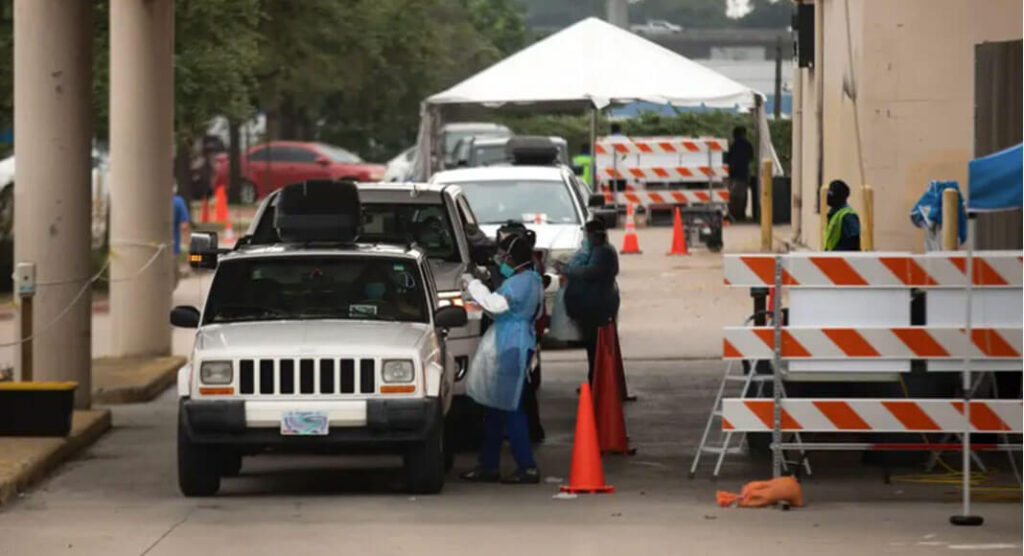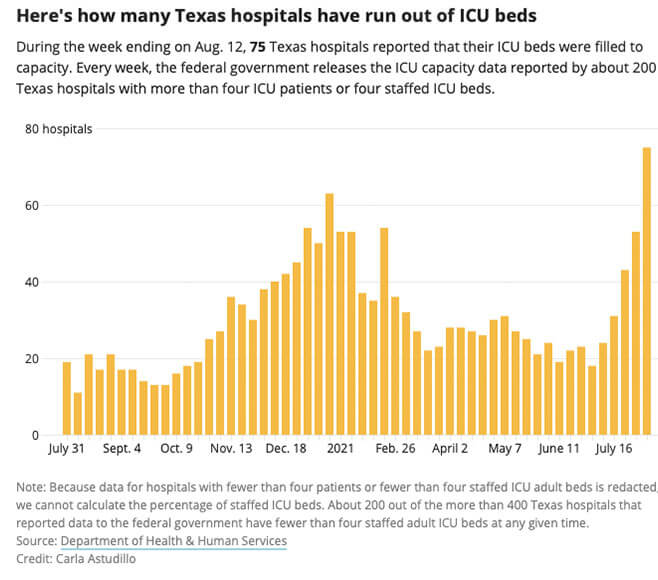
The Texas Tribune
BY KAREN BROOKS HARPER AND CARLA ASTUDILLO / The Texas Tribune
More Texas hospitals are reporting a shortage of ICU beds than at any other time since the COVID-19 pandemic hit the state 18 months ago — just one sign among many that the health crisis is on track to reach its most dangerous phase yet, health officials say.
The latest surge of the virus has also caused new cases and COVID-19 hospitalizations to rise with record speed to just below their January peaks, as the highly contagious delta variant rips through the unvaccinated community at a rate up to eight times faster than earlier strains, officials said.
“We are entering the worst surge in sheer numbers,” said Dr. Mark Casanova, a palliative care specialist in Dallas and a member of the Texas Medical Association’s COVID-19 Task Force. “This is the fourth round of what should have been a three-round fight. We do have very sincere concerns that the numbers game is going to overwhelm us.”
Between 93% and 98% of hospitalized COVID patients, depending on the area, are unvaccinated, officials said. With just under half of Texans fully vaccinated, the state still has some 16 million people who have yet to be protected from the virus.
And they are filling the state’s intensive care units rapidly.
“This is the fourth round of what should have been a three-round fight.”
— Dr. Mark Casanova, a member of the Texas Medical Association’s COVID-19 Task Force
In Dallas County on Monday, only 16 intensive care beds were available to serve the county of 2.6 million and its surrounding areas. The day before that, it was 12, Casanova said.
The state has asked the federal government for five mortuary trailers in anticipation of a potential spike in deaths, which are climbing again after a low in July — although the daily deaths are still much lower than they were during previous surges.
The strain is showing across the state.
Last week in San Antonio, 26 minutes went by with no ambulances available to respond to 911 calls from the city’s 1.5 million residents. In Austin, paramedics are so understaffed and overworked that some ambulances have to sit unused because there is no one to run them, said Capt. Selena Xie, an Austin paramedic and head of the Austin EMS Association.
“We’re seeing call volumes that are breaking our records, outside of the [February] snowstorm,” Xie said.
In rural West Texas, a school district announced Monday it would be closed for the next two weeks in an attempt to slow the virus’ spread before it overwhelms the scant health care resources in the area.
And on Tuesday, overwhelmed Harris County officials offered $100 to anyone getting their first vaccine dose, a desperate attempt to stave off what one hospital CEO called “the worst surge that we have faced in the community.”
“The numbers at Harris Methodist and other hospital systems in this area have never gone up this far, this fast,” said Dr. Esmaeil Porsa, president and CEO of Harris Health System. “I’m begging you. Do the right thing. Get yourself vaccinated.”
Available ICU beds at pandemic low

Out of nearly 12,000 people hospitalized with COVID in Texas on Monday, more than a quarter of them are in the state’s ICU beds. At the end of last week, at least 75 Texas hospitals reported that they had no ICU beds available for patients — and more than 50 additional facilities said they had just one bed available at some point during the previous week.
Most of the shortages are occurring in major metro areas, near the Gulf Coast and in the eastern portions of the state, where vaccination rates are among the lowest in the state.
The pressure on the intensive care units affects not just COVID patients, but also others who need treatment for ailments not related to COVID, Casanova said.
“When you’re told by the powers that be that you have 12 ICU beds in Dallas County, that means you have 12 ICU beds for the traffic on I-35, 12 ICU beds for the stroke [victim], 12 ICU beds for the five borderline COVID patients we have in the hospital right now,” Casanova said. “When we say that we may come to be in a situation where we are looking at some impossible decisions about focusing our care and our efforts on those that have the highest likelihood of survival so that we can save as many lives as possible, that equation is not just for COVID patients. That occurs for all patients.”
And while hospitals are not at that point yet, Casanova said, it remains a real threat.
During the last surge in January, he said, “we skirted that by about two weeks.”
Hospitalizations approach a pandemic high
New COVID-19 cases have reached a seven-day average of more than 14,000, still below the January peak of more than 19,000. Gov. Greg Abbott became one of the newest cases on Tuesday. But the number that worries health officials most is hospitalizations from COVID-19, which hit 12,227 on Monday — an increase of 2,186 since last week.
If the trend continues, the state could surpass the single-day record of 14,218, set on Jan. 11, before the end of the month.
Dr. David Lakey, former Texas state health commissioner, said Tuesday that he’s not convinced Texas will hit that number statewide because some areas, like Austin, are starting to see a slight slowdown in admissions.
But he also noted that hospitalizations are not spiking at the same rate throughout Texas and that some areas will continue to struggle even if the numbers start to slow down.
In El Paso, for example, one of the most heavily vaccinated areas of the state, the numbers are staying manageable, he said — but Dallas and Houston have already hit or surpassed their January hospitalizations.
Statewide, Lakey said, “it’s going to be close.”
So far, hospitals have been able to take actions to avoid the sort of life-or-death decisions that come when there are too many patients and not enough staffed beds. They’ve shuffled staff, converted unused spaces into COVID units and postponed non-emergency surgeries.
At LBJ Hospital in Houston, tents were erected to take care of the COVID patient overflow, according to media reports.
At Parkland Hospital in Dallas, officials sometimes hold patients in the emergency department waiting for ICU beds to open up, said Joseph Chang, chief medical officer at Parkland Health and Hospital System.
“That is becoming more and more common as COVID spreads like wildfire in the community,” Chang said in an emailed statement to the Tribune.
The hospital, which typically has a high patient count in the ICU even in non-COVID times, has been turning away ambulances for weeks, he said.
“We have enacted many protocols to make more staff and space available,” he said.
But with beds unavailable because they can’t be staffed and the numbers continuing to rise, Casanova said he worries about hospitals reaching their breaking point.
“We’ve surged what we can surge,” he said. “A power strip only has so much, and eventually you’re going to blow it. And I think we’re about to blow it — in a euphemistic way, and in a literal way.”









